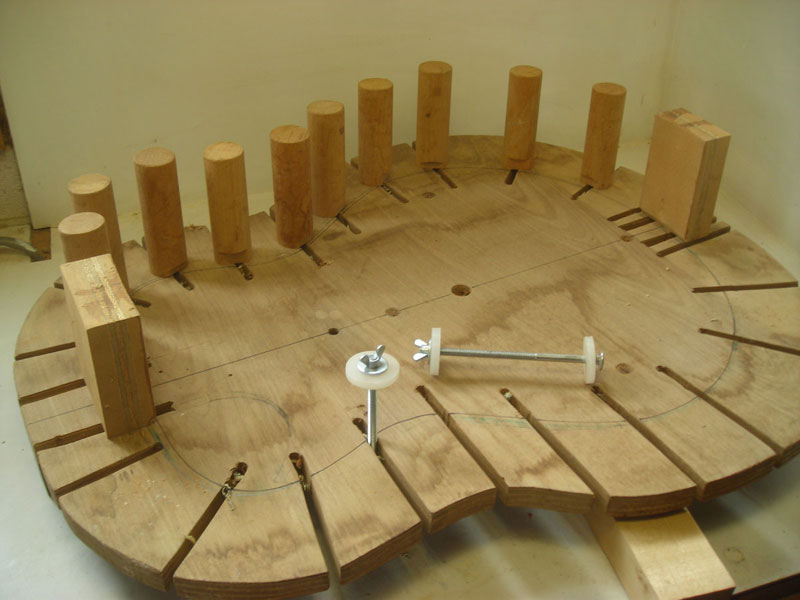
 |
|
#1
|
|||
|
|||
|
Hello. I've repaired acoustic guitars but am starting my own build for the first time. I made a pattern of half of the guitar top that I want to build and I'll be needing to build a mold and a form for side bending. How deep does the mold need to be? Also, what type plywood would you use? Any and all suggestions welcome. Thanks
|
|
#2
|
|||
|
|||
|
If you use 4 pieces of 3/4" plywood, you would have about 3" thick mold which should be enough.
|
|
#3
|
|||
|
|||
|
Yes 3 inches is nice, I use 2 and 1/4 when making my molds, just because that is the thickness the sheets make glued up
Steve
__________________
Cole Clark Fat Lady Gretsch Electromatic Martin CEO7 Maton Messiah Taylor 814CE |
|
#4
|
|||
|
|||
|
|
|
#5
|
|||
|
|||
|
Hey thanks to all! How do you trim the sides to length, to get a nice seam, especially at the tail block?
|
|
#6
|
|||
|
|||
|
Quote:
One approach is to create a 3/4" plywood board that is guitar-shaped, but oversize and add a bunch of slots from the edges. In the slots, use dowels with threaded rod projecting from one end. These can then be bolted to the slotted board to create a "variable-shape" outside mold, using the dowels, threaded rod, wing nuts, washers and the plywood board. 
|
|
#7
|
|||
|
|||
|
That form looks interesting but perhaps more difficult to build. I just might build more than one from the mold I'll make.
Here's my project idea. Build a round neck resonator guitar the size and shape of a Gibson J-45, but with the Martin 25.4 scale. I have some nice looking bubinga for the back and sides. I converted a regular dread acoustic to a resonator and I love the way it sounds. Made an entirely new top for it. Huge job. Believe it or not, the intonation is about perfect and its a joy to play. Doesn't look the best. Really needs a refin to look better. But I want to attempt to build one and make it even better if possible. Chet Atkins used a Delvecchio round neck resonator guitar on a lot of recordings. Love that sound. |
|
#8
|
||||
|
||||
|
I donít use a mold at all, and havenít for 20 years. I question the need for them at all. They slow down the building process and rigidify it, getting in the way of creativity and growth. They are really only useful in production situations where relatively unskilled labor is used and a specific product is the necessary result. The mold allows many sins to be obscured, allowing more consistent appearing results, but also permitting more mediocre performing results. Check out my threads in the Custom Shop for useful information on my process.
|
|
#9
|
|||
|
|||
|
Quote:
|
|
#10
|
|||
|
|||
|
Quote:
|
|
#11
|
|||
|
|||
|
Quote:
i've used fox type benders, inner and outer molds, and for me the freedom of flexibility by going mold-less is hard to beat. i no longer have to chunk out a mold for every different thing i might want to make -nor find a place to store them either. Last edited by arie; 02-23-2018 at 02:47 PM. |
|
#12
|
|||
|
|||
|
More like an opinion by a highly accomplished luthier, just because a person feels a certain way does not make it trash talking. He explained why he holds that opinion and his points are valid to a certain extent. It depends on how you approach building, as an assembler of pieces or as an artist of sound. Building as Bruce does is no harder than building in a mold, it just takes a different tact to get where one wants to go. I build without a mold myself, I watching how Bruce builds and it resonated with me so I tried it. It is no harder if you can visualize what you are trying to do.
__________________
Fred Last edited by printer2; 02-23-2018 at 04:39 PM. |
|
#13
|
|||
|
|||
|
Sergei de Jonge uses fixed molds.
|
|
#14
|
|||
|
|||
|
Quote:
In my book, this qualifies as trash talking. |
|
#15
|
|||
|
|||
|
The "German", as opposed to the "Spanish", method of guitar making generally uses an outside mold. (Spanish assembles on a board, top facing down, then sides, then back.)
Guitar making in Canada started with Edgar Monch, a German classical guitar maker, who lived for a time in Canada prior to returning to Germany. While in Canada, he taught several people, the most famous of which was Jean Larrivee. He, in turn, taught a number of apprentices, including Sergei, Grit Laskin, Linda Manzer, David Wren and others. All of them use an outside mold for assembly per the German tradition. |